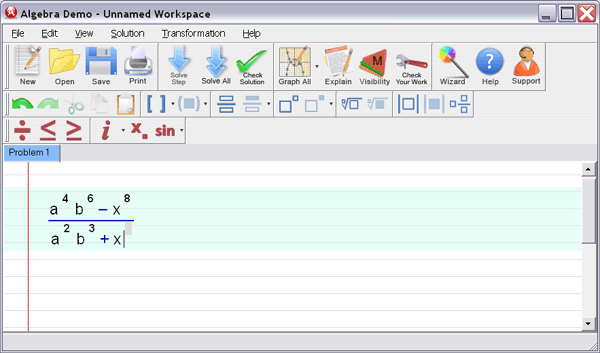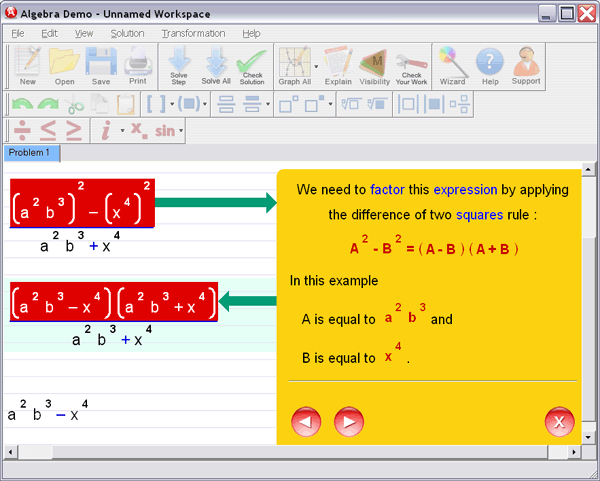The California Mathematics Content Standards
Grade Five Mathematics Content Standards
By the end of grade five, students increase their facility
with the four basic arithmetic
operations applied to fractions and decimals and learn to add and subtract
positive and
negative numbers. They know and use common measuring units to determine length
and
area and know and use formulas to determine the volume of simple geometric
figures.
Students know the concept of angle measurement and use a protractor and compass
to
solve problems . They use grids, tables, graphs, and charts to record and analyze
data.
Note: The sample
problems illustrate
the standards and
are written to help
clarify them. Some
problems are written
in a form that can be
used directly with
students; others will
need to be modified,
particularly in the
primary grades,
before they are
used with students.The symbol

identifies the key
standards for
grade five.
|
Number Sense
1.0 Students compute with very large and very small numbers, positive
integers,
decimals, and fractions and understand the relationship between
decimals,
fractions, and percents. They understand the relative magnitudes of
numbers:
1.1 Estimate, round, and manipulate very large
(e.g., millions) and very small
(e.g., thousandths) numbers.
 Interpret
percents as a part of a hundred; find decimal and percent equivalents Interpret
percents as a part of a hundred; find decimal and percent equivalents
for common fractions and explain why they represent the same value;
compute a given percent of a whole number.
A test had 48 problems. Joe got 42 correct.
1. What percent were correct?
2. What percent were wrong?
3. If Moe got 93.75% correct, how many problems did he get correct?
1.3 Understand and compute positive integer powers
of nonnegative integers;
compute examples as repeated multiplication.
Extend the tables shown below:

 Determine the
prime factors of all numbers through 50 and write the Determine the
prime factors of all numbers through 50 and write the
numbers as the product of their prime factors by using exponents to show
multiples of a factor (e.g., 24 = 2 × 2 × 2 × 3 = 23 × 3).
Find the prime factorization of 48 and use
exponents where appropriate.
 Identify and
represent on a number line decimals, fractions, mixed numbers, Identify and
represent on a number line decimals, fractions, mixed numbers,
and positive and negative integers.
2.0 Students perform calculations and solve
problems involving addition, subtraction,
and simple multiplication and division of fractions and decimals:
 Add,
subtract, multiply, and divide with decimals; add with negative Add,
subtract, multiply, and divide with decimals; add with negative
integers; subtract positive integers from negative integers; and verify
the
reasonableness of the results.
Determine the following numbers:
1. 11 + (-23)
2. (-15) - 128
3. (-27) + (-45)
 Demonstrate
proficiency with division, including division with positive Demonstrate
proficiency with division, including division with positive
decimals and long division with multidigit divisors.
Find the quotient:
6 divided by .025
 Solve simple
problems, including ones arising in concrete situations, involving Solve simple
problems, including ones arising in concrete situations, involving
the addition and subtraction of fractions and mixed numbers ( like and
unlike denominators of 20 or less ), and express answers in the simplest
form.
Given the following three pairs of fractions
(3/8 and 1/6,
 and and
 ,
16 and ,
16 and
 ),
find for each pair its: ),
find for each pair its:
1. Sum
2. Difference
2.4 Understand the concept of multiplication and
division of fractions.
2.5 Compute and perform simple multiplication and division of fractions
and
apply these procedures to solving problems.
Given the following three pairs of fractions (3/8 and 1/6,
 and and
 , 16 and , 16 and
 ), find for each pair its: ), find for each pair its:
1. Product
2. Quotient in simplest terms
Ericka has  yards of cloth to make
shirts. Each shirt requires 7/8 yard. yards of cloth to make
shirts. Each shirt requires 7/8 yard.
How many shirts can she make? How much cloth will she have left over?
|
|
| |
Algebra and Functions
1.0 Students use variables in simple expressions, compute the value of
the expression
for specific values of the variable, and plot and interpret the results:
1.1 Use information taken from a graph or equation to answer questions
about a
problem situation.
 Use a letter
to represent an unknown number ; write and evaluate simple Use a letter
to represent an unknown number ; write and evaluate simple
algebraic expressions in one variable by substitution.
3x + 2 = 14. What is x?
1.3 Know and use the distributive property in equations and expressions
with
variables.
 Identify and
graph ordered pairs in the four quadrants of the coordinate Identify and
graph ordered pairs in the four quadrants of the coordinate
plane.
Plot the points (1, 2), (-4, -3), (12, -1), (0, 4), (-4, 0).
 Solve
problems involving linear functions with integer values; write the Solve
problems involving linear functions with integer values; write the
equation ; and graph the resulting ordered pairs of integers on a grid.
|
|
| |
Measurement and Geometry
1.0 Students understand and compute the volumes and areas of simple
objects:
 Derive and
use the formula for the area of a triangle and of a parallelogram Derive and
use the formula for the area of a triangle and of a parallelogram
by comparing it with the formula for the area of a rectangle (i.e., two
of the
same triangles make a parallelogram with twice the area; a parallelogram
is
compared with a rectangle of the same area by pasting and cutting a
right
triangle on the parallelogram).
Find the area and perimeter.

 Construct a
cube and rectangular box from two-dimensional patterns and Construct a
cube and rectangular box from two-dimensional patterns and
use these patterns to compute the surface area for these objects.
 Understand the
concept of volume and use the appropriate units in common Understand the
concept of volume and use the appropriate units in common
measuring systems (i.e., cubic centimeter [cm 3], cubic meter
[m3], cubic
inch [in. 3], cubic yard [yd.3]) to compute the
volume of rectangular solids.
1.4 Differentiate between , and use appropriate
units of measures for, two- and
three-dimensional objects (i.e., find the perimeter, area, volume).
2.0 Students identify, describe, and classify the properties of, and
the relationships
between, plane and solid geometric figures:
 Measure,
identify, and draw angles, perpendicular and parallel lines, Measure,
identify, and draw angles, perpendicular and parallel lines,
rectangles, and triangles by using appropriate tools (e.g.,
straightedge,
ruler, compass, protractor, drawing software).
 Know that the
sum of the angles of any triangle is 180° and the sum Know that the
sum of the angles of any triangle is 180° and the sum
of the angles of any quadrilateral is 360° and use this information to
solve
problems.
2.3 Visualize and draw two-dimensional views of
three-dimensional objects
made from rectangular solids.
|
|
| |
Statistics, Data Analysis, and Probability
1.0 Students display, analyze, compare, and interpret different data
sets, including
data sets of different sizes:
1.1 Know the concepts of mean, median, and mode; compute and compare
simple examples to show that they may differ.
1.2 Organize and display single-variable data in appropriate graphs and
representations
(e.g., histogram, circle graphs) and explain which types of graphs are
appropriate for various data sets.
1.3 Use fractions and percentages to compare data sets of different
sizes.
 Identify
ordered pairs of data from a graph and interpret the meaning of the Identify
ordered pairs of data from a graph and interpret the meaning of the
data in terms of the situation depicted by the graph.
 Know how to
write ordered pairs correctly; for example, (x, y). Know how to
write ordered pairs correctly; for example, (x, y).
|
|
| |
Mathematical Reasoning
1.0 Students make decisions about how to approach problems:
1.1 Analyze problems by identifying relationships, distinguishing
relevant
from irrelevant information, sequencing and prioritizing information,
and observing patterns.
1.2 Determine when and how to break a problem into simpler parts.
2.0 Students use strategies, skills, and concepts in finding
solutions:
2.1 Use estimation to verify the reasonableness of calculated results.
2.2 Apply strategies and results from simpler problems to more complex
problems.
2.3 Use a variety of methods, such as words, numbers, symbols, charts,
graphs,
tables, diagrams, and models, to explain mathematical reasoning.
2.4 Express the solution clearly and logically by using the appropriate
mathematical
notation and terms and clear language; support solutions with
evidence in both verbal and symbolic work .
2.5 Indicate the relative advantages of exact and approximate solutions
to
problems and give answers to a specified degree of accuracy.
2.6 Make precise calculations and check the validity of the results from
the
context of the problem.
3.0 Students move beyond a particular problem by generalizing to
other
situations:
3.1 Evaluate the reasonableness of the solution in the context of the
original
situation.
3.2 Note the method of deriving the solution and demonstrate a
conceptual
understanding of the derivation by solving similar problems.
3.3 Develop generalizations of the results obtained and apply them in
other
circumstances. |
|
Start solving your Algebra Problems
in next 5 minutes!
 |
 |
 |
|
Algebra Helper
Download (and optional CD)
Only $39.99
|
|
Click to Buy Now:
OR
|
|
|
 |
 |
 |
|
2Checkout.com is an authorized reseller
of goods provided by Sofmath
|
|
Attention: We are
currently running a special promotional offer
for Algebra-Answer.com visitors -- if you order
Algebra Helper by midnight of
January 22nd
you will pay only $39.99
instead of our regular price of $74.99 -- this is $35 in
savings ! In order to take advantage of this
offer, you need to order by clicking on one of
the buttons on the left, not through our regular
order page.
If you order now you will also receive 30 minute live session from tutor.com for a 1$!
|
You Will Learn Algebra Better - Guaranteed!
Just take a look how incredibly simple Algebra Helper is:
Step 1
: Enter your homework problem in an easy WYSIWYG (What you see is what you get) algebra editor:

Step 2 :
Let Algebra Helper solve it:

Step 3 : Ask for an explanation for the steps you don't understand:

Algebra Helper can solve problems in all the following areas:
- simplification of algebraic expressions (operations
with polynomials (simplifying, degree, synthetic division...), exponential expressions, fractions and roots
(radicals), absolute values)
- factoring and expanding expressions
- finding LCM and GCF
-
(simplifying, rationalizing complex denominators...)
- solving linear, quadratic and many other equations
and inequalities
(including basic logarithmic and exponential equations)
- solving a system of two and three linear equations
(including Cramer's rule)
- graphing curves (lines, parabolas, hyperbolas, circles,
ellipses, equation and inequality solutions)
- graphing general functions
- operations with functions (composition, inverse, range, domain...)
- simplifying logarithms
- basic geometry and trigonometry
(similarity, calculating trig functions, right triangle...)
- arithmetic and other pre-algebra topics
(ratios, proportions, measurements...)
ORDER NOW!
 |
 |
 |
|
Algebra Helper
Download (and optional CD)
Only $39.99
|
|
Click to Buy Now:
OR
|
|
|
 |
 |
 |
|
2Checkout.com is an authorized reseller
of goods provided by Sofmath
|
|
|
 |
| |
| "It
really helped me with my homework. I was
stuck on some problems and your software walked me
step by step through the process..." |
| C. Sievert, KY
| |
| |
 |
| |
Sofmath
19179 Blanco #105-234
San Antonio, TX 78258
|
Phone:
(512) 788-5675
Fax: (512) 519-1805
| | |



